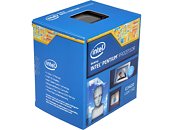Monday, December 9th 2019

Continuing 14 nm Supply Shortages Lead Intel to Reintroduce Haswell-based, 22 nm Pentium G3420
"Nothing Really Ends" is the title of a song from dEUS, a Belgian "art-rock" band. And it would seem this applies all too well to the world of technology too. Intel has issued a Product Change Notification (PCN) which has changed the previously dead and buried, Haswell-era, 22 nm Pentium G3420 from its "Discontinued" status back to a worded "canceling this Product Discontinuance completely per new roadmap decision and enabling the product long term once again." Which means the Pentium G3420 will have a new lease of life, and will be available to customers until May 2020, with final shipments on December of the same year.
This is clearly an attempt from Intel to increase part availability for OEMs and system manufacturers, who have already been quoted as considering AMD due to both increases in performance and efficiency in their processors, as well as constrained supply from Intel, with giant Dell already having pointed the finger at Intel as a cause for their lower than expected revenue.This 22 nm part won't break any records, and will likely only be of interest to the lowest tier systems - which will, anyway, move some demand from the 14 nm node back this 22 nm one, enabling Intel to produce more of the higher revenue, higher performance solutions on that node. Of course, why would any system integrator build a system with this CPU instead of AMD's Athlon 3000G is anyone's guess (it won both our Great Value and Highly Recommended awards, so it's not a guess for us here at TPU). Care to make yours in the comments?
Source:
NotebookCheck
This is clearly an attempt from Intel to increase part availability for OEMs and system manufacturers, who have already been quoted as considering AMD due to both increases in performance and efficiency in their processors, as well as constrained supply from Intel, with giant Dell already having pointed the finger at Intel as a cause for their lower than expected revenue.This 22 nm part won't break any records, and will likely only be of interest to the lowest tier systems - which will, anyway, move some demand from the 14 nm node back this 22 nm one, enabling Intel to produce more of the higher revenue, higher performance solutions on that node. Of course, why would any system integrator build a system with this CPU instead of AMD's Athlon 3000G is anyone's guess (it won both our Great Value and Highly Recommended awards, so it's not a guess for us here at TPU). Care to make yours in the comments?

42 Comments on Continuing 14 nm Supply Shortages Lead Intel to Reintroduce Haswell-based, 22 nm Pentium G3420
Can you provide a link to where Intel specifically addressed this and said it would be "completely untouched"??
One that is coming (actually hitting like a brick) to my mind is that will do anything possible to prevent OEMs and system manufacturers to go to AMD, and probably will give away for free those mummified chips along with sexual favors...
...that kind of desperation we are talking about!
that will help with 14nm shortage won't it, neither uses 14nm.
Also socket is different, they buy a different socket as they are still manufactured.
And it isn't like they are bringing back some long dead product here, it literally just went EoL on Nov 26th, then about a week later they changed it back. They've been selling this CPU all the way up until just a few weeks ago. People have been buying this processor, or it wouldn't have stayed active as long as it did, and I'm also guessing there was a backlash from the people that have been buying it when it did go EoL. Which is why Intel changed their mind a week after discontinuing it.
www.tomshardware.com/news/intel-we-arent-stepping-back-to-22nm-haswell-we-never-left
It's always been known there are tons of AMD fans on the Internet most of whom disregard logic, reasoning and rationale but it's sad to see that newsmakers are following the suit.
@W1zzard
Can you please ask your newsmakers to stop giving their wild interpretation of the things they are reporting on? And also, it would be great if they reported rumors as rumors.
You see the word play here when Intel uses phrases "never left" "never intended to leave" right? If they put 22nm CPUs in desktop/server/workstations etc. that is a step back nonetheless because those industry computer that could use 22nm chips are doing it already so let us wait and see which computers now are going to end up with 22nm chips. Maybe low-end desktops?